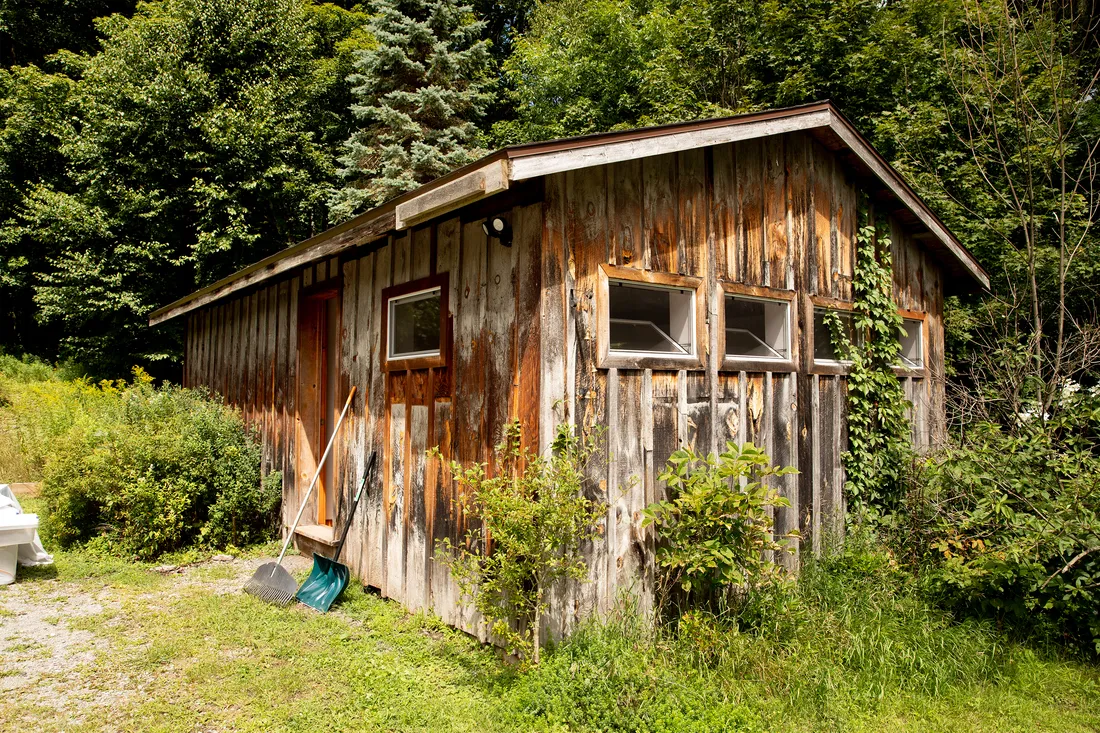The Subject

Ross Oscar Knight, executive director of photography at Syracuse University, traveled to Oneonta, New York, to capture English professor George Saunders G’88 (shown here) for a recent issue of Syracuse University Magazine. The following is a firsthand account of his visit to the former home of the 2023 winner of the Library of Congress Prize for American Fiction.
The Cover Shot

There’s a lot of symbolism here. The heart-shaped pages represent George’s love of teaching—a willingness to dive deep and give candid advice. The bulb conveys the illumination of knowledge passing from one generation to the next. His blue attire, while comfortable and welcoming, denotes responsibility. The color also echoes the University’s visual identity. George’s quiet confidence and penetrating gaze speak volumes.
(Photo Specs—Camera: Canon 5D Mark IV; Lens: EF 70-200mm f/2.8L IS III USM; Aperture: f/6.3; Shutter Speed: 1/160; White Balance: Custom; Lighting: Profoto B1X flash.)
A Swim in a Pond in the Rain

It rained all the way to George’s house in Oneonta, located two hours southeast of campus. As I pulled into his driveway, the sun broke through the clouds, and I was greeted by his kind blue eyes, seemingly tired from packing. He and his novelist wife, Paula Saunders G’87, had been moving the rest of their belongings to Santa Cruz, California, from which he now commutes to Syracuse to teach.
Precious Cargo

After introducing myself to George, I began unloading my van, which contained enough equipment and furniture to fill a small movie set—four chairs; two utility carts; a bag of books; a desk, chair and lamp set; sheets of plexiglass; and lighting equipment. I was ready for anything.
Location: The Writing Shed

Scouting is a key part of preproduction, so my first visit was to George’s writing shed, situated across the driveway from his house. Despite not having a clear shot, I wasn’t lost on the building’s significance. The shed has borne witness to most of George’s bestsellers. His latest book, Liberation Day, came out in October of 2022.
Interior Dialogue

George cautioned me that the shed’s interior had become “overused” by other photographers. It also had been dismantled. As a result, the inside barely resembled the spartanly furnished abode I had seen in photos online. Still the shed holds many memories for him. And now me.
Into the Woods

While scouting locations, George pointed out highlights of his 15-acre wooded property. They included his favorite path, where he often went to empty his mind or brainstorm literary ideas. This clearing also appeared in the background of the magazine’s cover image—a nod to the creative journey on which George and his students have embarked.
Ancient Wisdom, Modern Times

George’s embrace of Tibetan Buddhism was evident from the multiple Buddha statues and prayer flags on his property. When he left our scouting exercise, I closed my eyes and imagined him meditating and then writing at his desk. The idyllic setting was part home, part retreat.
Strike a Pose

In anticipation of the shoot, George gave me a bag of foreign editions of his books. I arranged them so that when he held the stack, the spine of I Can Speak (from Germany) covered his mouth. If anyone has built a career on finding his voice, it’s George.
Illuminating Greatness

Lighting helps me create a mood and tell a story. It also enables the subject to stand out from the background. I spent hours before the shoot testing the natural light and preparing for almost any scenario, including direct sunlight, diffused sunlight and shade.
Candid Camera

As a photographer, I strive to capture people in unguarded moments. Such occasions contain verbal and nonverbal cues that establish trust and credibility. George is like an open book—vulnerable, tender and authentic. He exudes a knowingness.
Steppin’ Out

I logged more than 20,000 steps while photographing George—the equivalent of walking nine miles or climbing the stairs of a 50-story building. I also burned over 5,400 calories. I spent the two-hour drive home reflecting on my experience and feeling a sense of gratitude for my new friendship.


